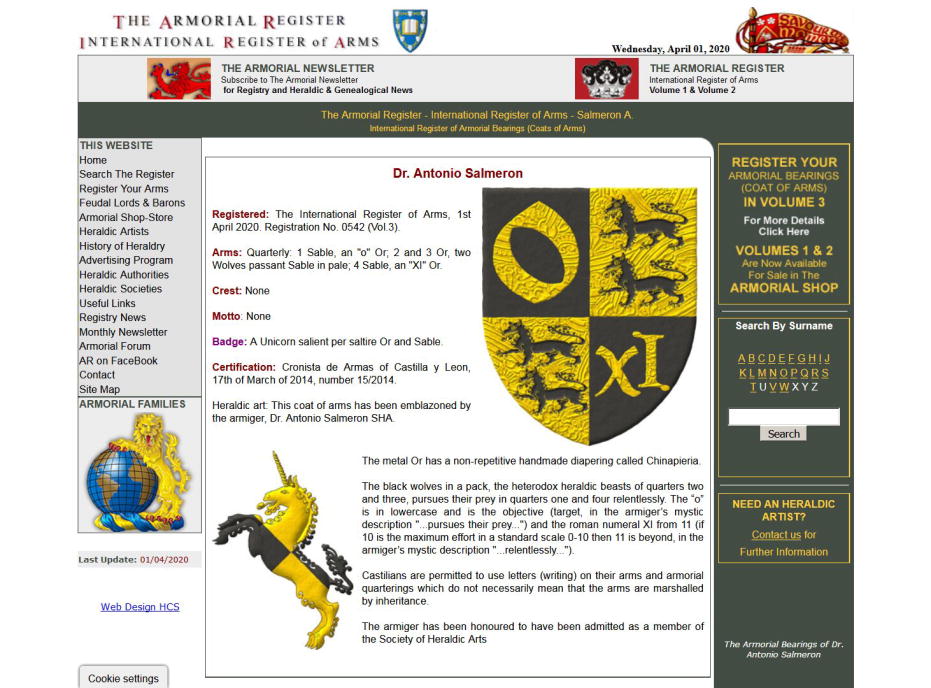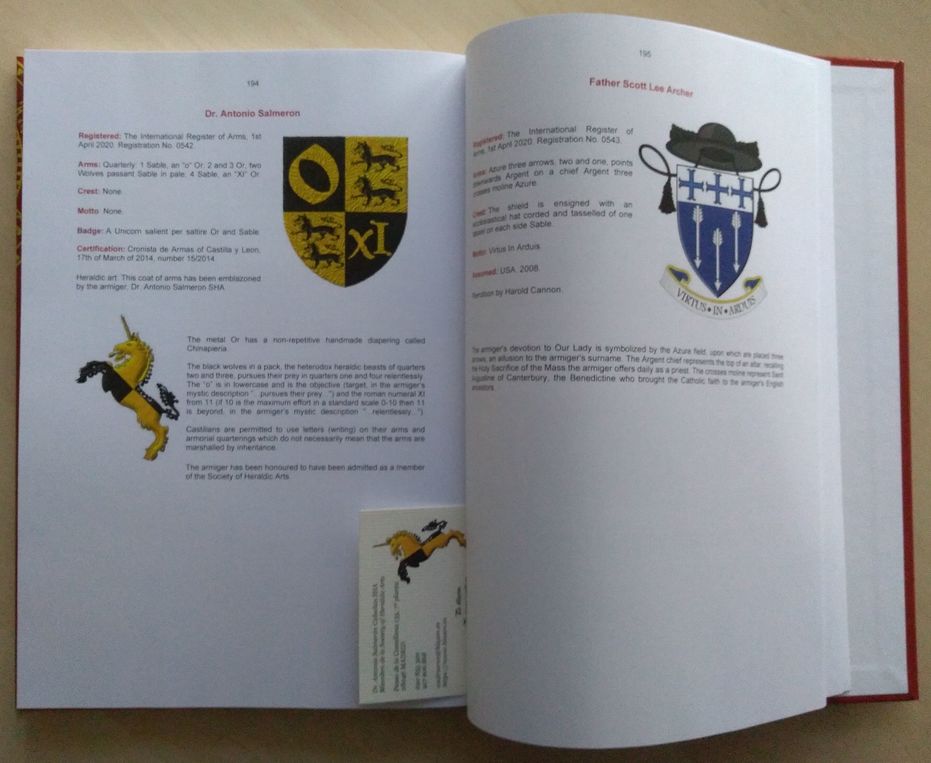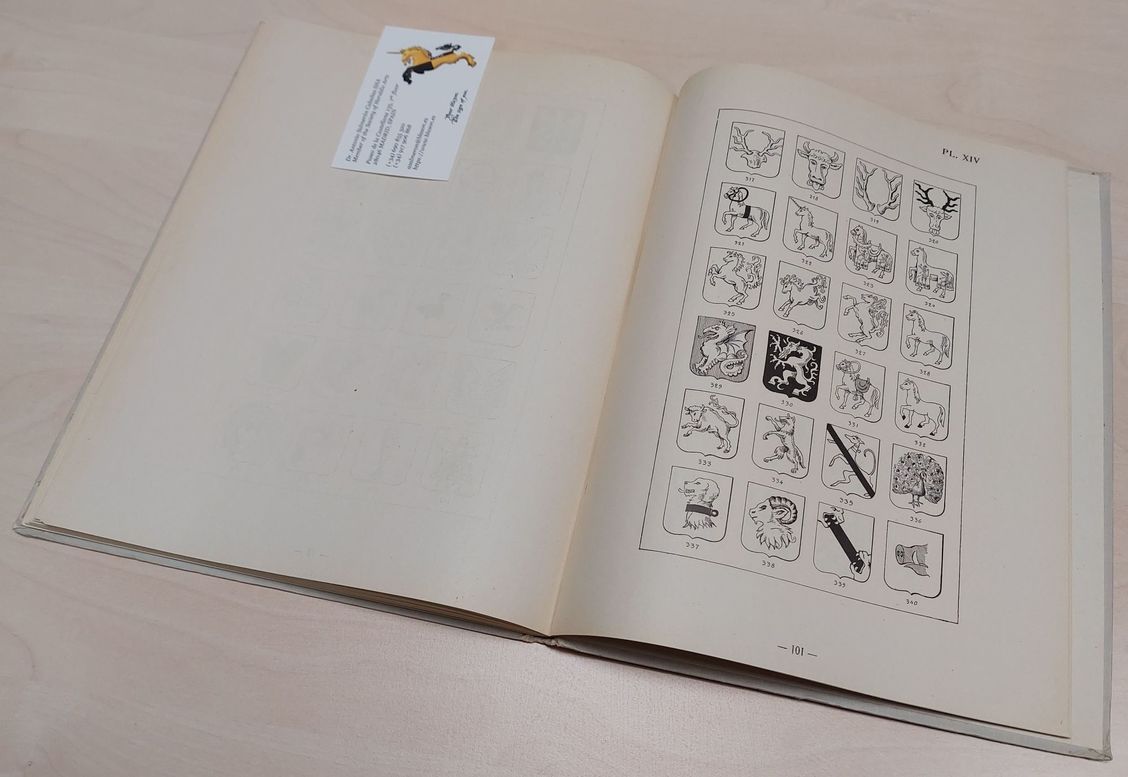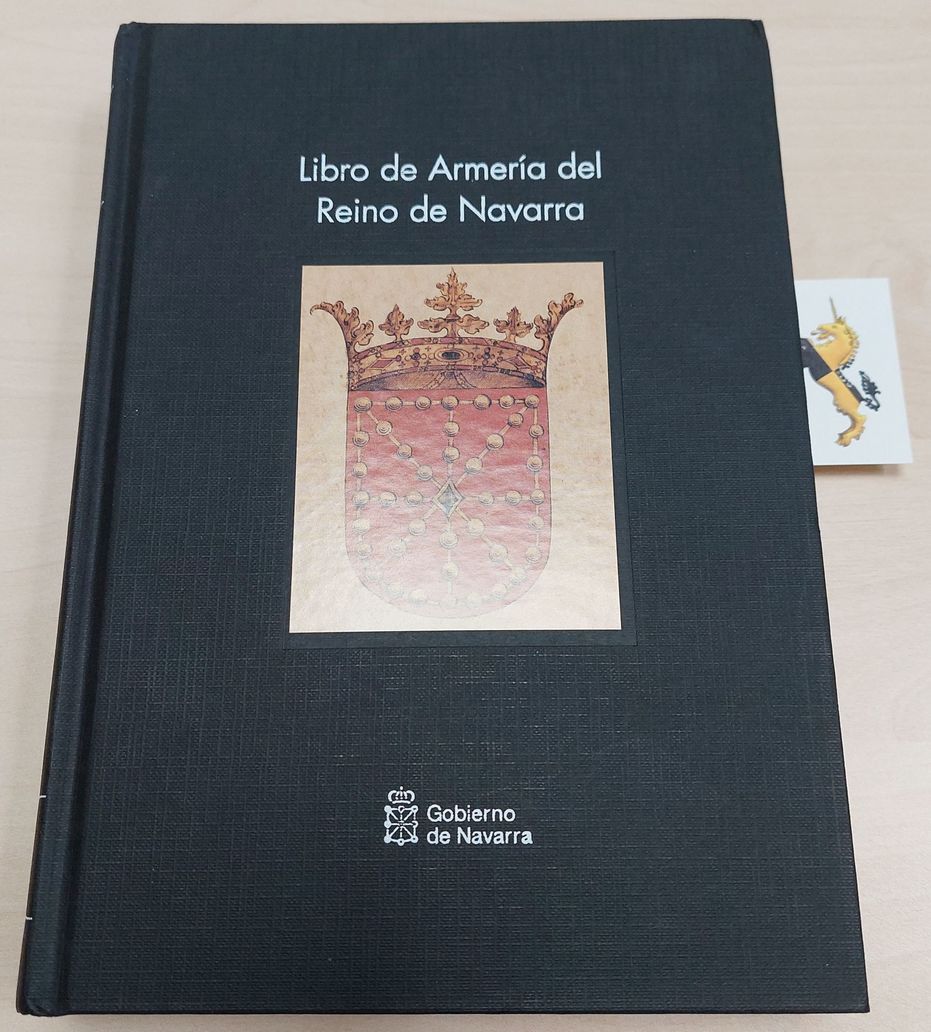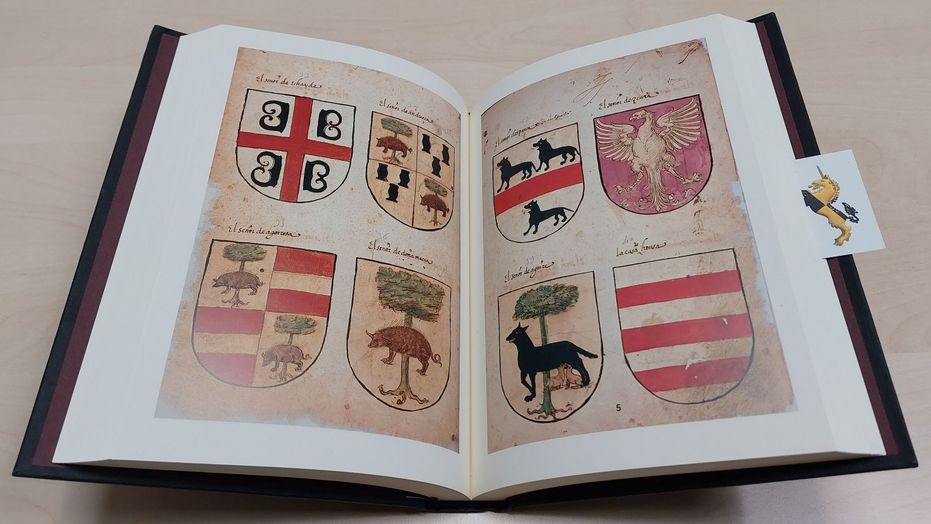
Antonio Salmeron, The Armorial Register
Registered by The International Register of Arms, 1st of April of 2020, Registration number 0542, Volume 3.
[Armorial Register, T.; 2020; page 194].
Categories: Armorial roll, Quarterly, Or, Sable, Two, Wolf and Passant.
External link:
Root: The Armorial Register.


Ackerson - Akers, lineage
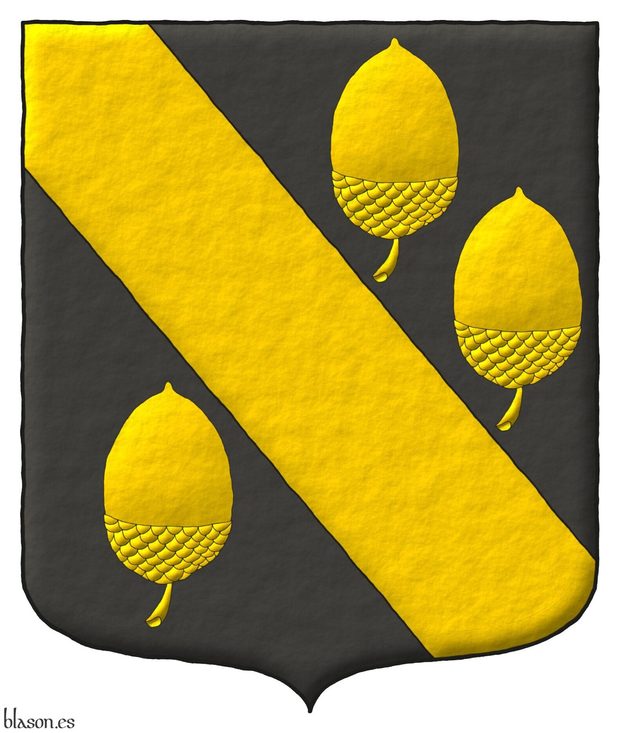
Ackerson and Akers lineages.
Sable, a Bend between three Acorns Or.
Illuminated and freehand finishing.
The coat of arms of Ackerson and Akers lineages emblazoned by me and extracted from [Burke, B.; 1989].
Unless the blazon specifies another layout, when a bend is between three charges, this charges are ordered, two in the chief and one in the base, as the three acorns do in this case.
[Rietstap, J. B.; 1861] escribe el blasón de «Ackers ou Akers» como «de sable, à une bande d'or, acc. de trois glands du mesme».
Blazon keywords: Sable, Bend, Between, Three, Acorn, Or and Ordered.
Style keywords: Freehand, Outlined in sable and Illuminated.
Classification: Interpreted.


![Ver [Cofradía de Santiago; Century XIV] en referencias bibliográficas. Libro abierto, hojas de plata, filo de oro, guardas de gules, tapas de sable.](../css/Libro.Bibliografia.png)
Cofradía de Santiago; Century XIV
Anonymous, «Libro de la Cofradía de Caballeros de Santiago de la Fuente», held by the Brotherhood of Santiago, Burgos Cathedral, manuscript, illustrated, 94 leaves, 21 missing, folio size, 29 x 21 centimeters, Burgos, 1338-1636.
Introduction
The illuminated manuscript chronicles the history and membership of the Brotherhood of Knights of Santiago in Burgos. Founded in 1338 during the reign of King Alfonso XI, as indicated by the preamble to the Rule on folio 27 verso, the Brotherhood was composed of members of the social and political elite of Burgos. The manuscript spans several centuries, primarily from the 14th to the 17th century.
The first 13 folios include a record of four deeds dating from 1396 to 1415, all related to the financial dealings of the Brotherhood.
Folio 14 marks the beginning of the original Rule of the Brotherhood, adorned with an illuminated initial «E» and a vignette of Christ flanked by saints and angels.
Portraits and illumination
The manuscript includes a list of the members, known as «cofrades» in Castilian, alongside their portraits and coats of arms. The book contains 295 portraits, added over time, with the last one dated to 1636.
The knights depicted in the manuscript held significant roles in the city, such as mayors, scribes, and other high offices. Many of the knights' families, like the Camargos from France and the Sanchestels from England, are noted for their diverse origins.
The portraits begin on page 21, initially with four to a page until folio 44, after which the number decreases to three, two, and eventually single figures per page.
Binding and preservation
The manuscript is bound in red leather with gold fillets and clasps, a 19th-century binding aimed at preserving the parchment pages. Originally, it had 94 leaves, but 21 are now missing, as noted in a contemporary annotation at the front.
Bibliographical reference of century XIV.
Classification: Manuscript, Armorial roll, Castilian language and In color.
The author is anonymous.
Here are the articles quoting this reference:
Internal resources: 86 images in JPEG format.


![Ver [Académie internationale d'héraldique; 1952] en referencias bibliográficas. Libro abierto, hojas de plata, filo de oro, guardas de gules, tapas de sable.](../css/Libro.Bibliografia.png)
Académie internationale d'héraldique; 1952
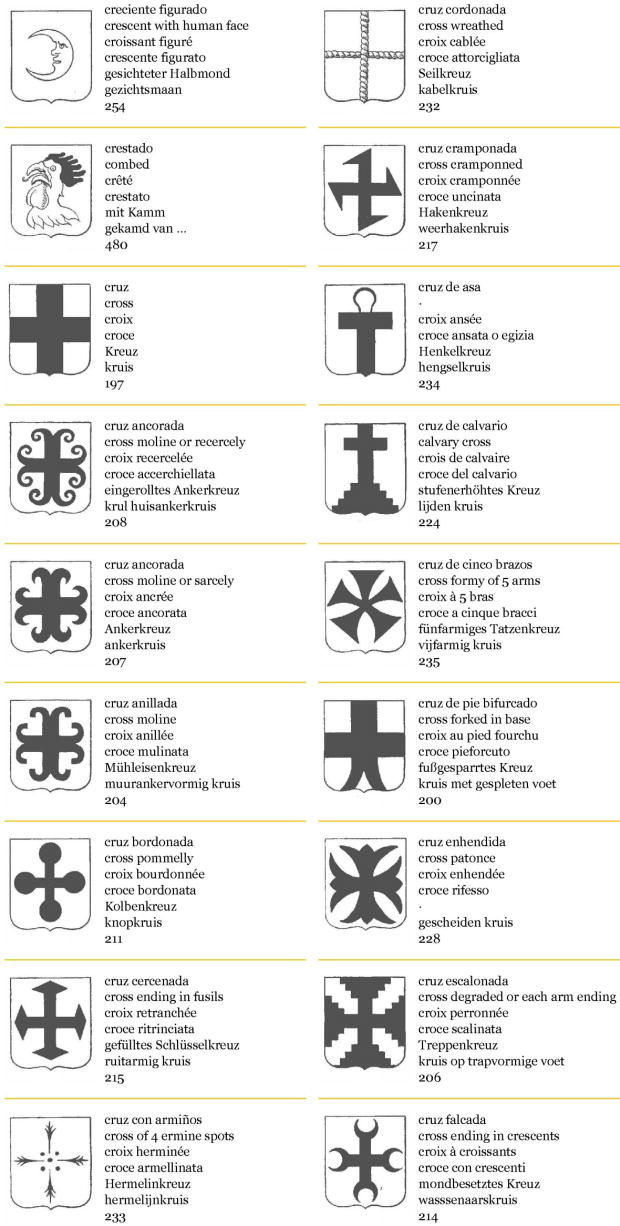
Académie internationale d'héraldique, AIH, «Vocabulaire-Atlas Héraldique en six Langues: Francais - English - Deutsch - Español - Italiano - Nederlandsch», by Gaston Stalins, Le Baron Stalins, with the collaboration of René Le Juge De Segrais, Ottfried Neubecker, Martin de Riquer y Morera, Giacomo Carlo Bascapé, and Mario Gorino-Causa, 119 pages, 530 black and white heraldic pictures, Société du Grand Armorial de France, 179 Boulevard Haussmann, París, 1952.
This book begins with the following sentence: «Heraldique - science et art - qui prit naissance en France vers la moitié du XIIe siècle, s'est propagée très rapidement dans les principaux pays européens».
The number of terms and words of the heraldry by languages is as follows:
- French language: 523 heraldic terms.
- Dutch language: 521 heraldic terms.
- German language: 519 heraldic terms.
- Spanish language: 511 heraldic terms.
- Italian language: 506 heraldic terms.
- English language: 502 heraldic terms.
The names of the authors and collaborators have been checked with [Académie internationale d'héraldique; 1999].
Its 530 heraldic illustrations correspond, according to my calculations to 509 drawings, numbered from 1 to 530. Some images contain several numbers, for example, the image that shows a coat of arms with its mantling, number 528, and its supporters, number 529, a griffin and a lion rampant, it is the same illustation, but with 2 numbers.
Bibliographical reference of century XXI.
Classification: Dictionary, French language, English language, German language, Castilian language, Italian language and Dutch language.
Authors:
- Stalins, Gaston.
- Le Juge De Segrais, René.
- Neubecker, Ottfried.
- Riquer y Morera, Martin de.
- Bascapé, Giacomo Carlo.
- Gorino-Causa, Mario.
Bibliographic reference mentioned in the following articles:
- Ixai Lanzagorta Ochoa, plain tincture
- Pile issuant from the base in the Dictionary of the Spanish Language
- Sanz Lacorte, J.; 2007
- Sir Thomas Grenville II
- Val'Quirico, wreath an owl
External link:
Internal resources: Aih1952.00.Vocabulaire.Original.pdf, Aih1952.01.Vocabulaire.Sefidn.pdf and Paper edition with a Swedish bookplate.


![Ver [Martinena Ruiz, J. J.; Menéndez Pidal de Navascués, F.; 2001] en referencias bibliográficas. Libro abierto, hojas de plata, filo de oro, guardas de gules, tapas de sable.](../css/Libro.Bibliografia.png)
Martinena Ruiz, J. J.; Menéndez Pidal de Navascués, F.; 2001
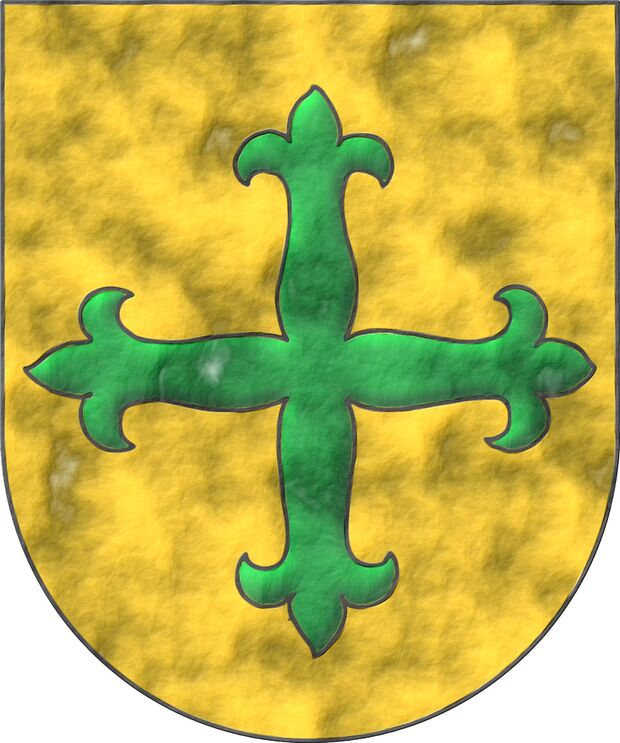
Juan José Martinena Ruiz and Faustino Menéndez Pidal de Navascués, «Book of Armory of the Kingdom of Navarra», Published by the Institución Príncipe de Viana, Directorate-General for Culture, Government of Navarra, 484 pages, ISBN-13 978-84-235-2166-1, ISBN-10 84-235-2166-4, Pamplona, 2001.
Reproduction and transcription of the manuscript armorial [Bosque, J. del; 1540], that is, the copy of the «Book of Armory of the Kingdom of Navarra», preserved in the General Archive of Navarra.
The coat of arms accompanying this bibliographic reference is that of Rada de Navarra following Juan del Bosque.
Both authors had already written and published, separately, about the armorial [Bosque, J. del; 1540], an example of the first is [Martinena Ruiz, J. J.; 1982] and an example of the second is [Menéndez Pidal de Navascués, F.; 1974].
Bibliographical reference of century XXI.
Classification: De bibliotheca.
The 2 authors are Martinena Ruiz, Juan José and Menéndez Pidal de Navascués, Faustino.
Bibliographical reference mentioned in the following article:
External resources:


![Ver [Febrer, J.; Century XIII] en referencias bibliográficas. Libro abierto, hojas de plata, filo de oro, guardas de gules, tapas de sable.](../css/Libro.Bibliografia.png)
Febrer, J.; Century XIII
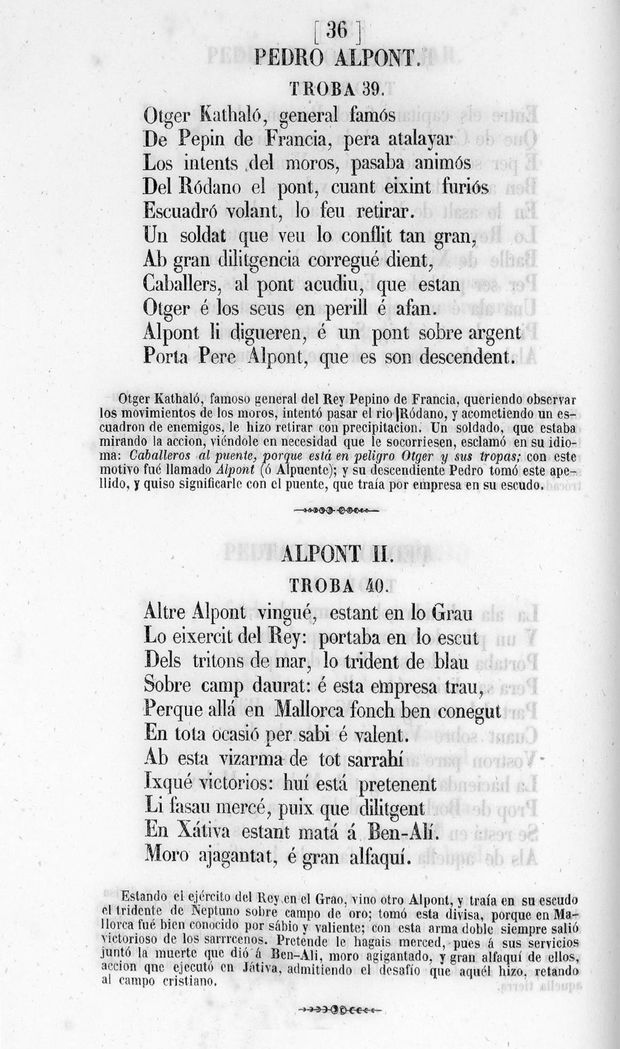
Jaime Febrer, «Trovas de Mossen Jaime Febrer: que tratan de los conquistadores de Valencia», edited by Joaquín María Bover, new edition made with reference to the first and an old manuscript, with notes, illustrated with portrait plates and heraldic plates, 312 pages, printed by Pedro José Gelabert, Palma, 1848.
Historical context and content
Jaime Febrer lived during the reigns of Jaime I El Conquistador, 1207-1276, and his son Pedro III El Grande of Aragon and I of Valencia, 1239-1285. Febrer is believed to have authored a manuscript detailing 278 knights who participated in the conquest of Valencia alongside Jaime I, forming the foundation of many noble lineages in the city and kingdom of Valencia.
The manuscript, dedicated to Pedro III and I of Valencia, is composed in short verses known as «trovas» ~ «trobas», written in the «Lemosín» language, an old form of Valencian. Each trova includes a description of the knights' coats of arms.
A re-edition of this manuscript was published by Joaquín María Bover in 1848 in Palma de Mallorca.
Illustrative example of trova 39, Alpont
The «trova 39» is dedicated to Pedro Alpont, whose ancestor helped the General Otger Kathaló and adopted the surname Alpont following an event involving a bridge. This poem «trova 39» serves as an illustrative example, describing the blazon of Pedro Alpont. The blazon described in this trova is simple: «Argent, a Bridge».
The story included in this trova tells how Otger Gotlant, also known as Oger Catalón or Catazlon, a general under King Pepin of France, was near the Rhône observing the Moors. He crossed the river by one of its bridges to better track the enemy’s movements. Suddenly, he was attacked by a squadron of Saracens, forcing him to retreat hastily. A soldier on the other side of the river saw this and began shouting in the Lemosín language, calling for reinforcements: «Al pont, caballers, al pont» ~ «To the bridge, knights, to the bridge», as Otger and his men were in danger. According to this «trova 39» by Jaime Febrer, from that moment on, this soldier was known by the surname Alpont. One of his descendants, named Pedro Alpont, participated in the conquest of Mallorca and later moved to Valencia, following King Jaime I El Conquistador, leaving behind the Alpont surname for his successors.
Another Alpont, referred to as Alpont II, appears in trova number 40, where his blazon is characterized by a trident.
Bibliographical reference of century XIII.
Classification: Valencian language and In black and white.
The author is Febrer, Jaime.
External resource:
Internal resources: FebrerJXIII.Trobas.BoverJM1848.Parcial.155.Paginas.pdf Partial PDF with the first 155 pages.


![Ver [Burke, J.; 1836] en referencias bibliográficas. Libro abierto, hojas de plata, filo de oro, guardas de gules, tapas de sable.](../css/Libro.Bibliografia.png)
Burke, J.; 1836
John Burke, «A Genealogical and Heraldic History of the Commoners of Great Britain and Ireland: Enjoying Territorial Possessions or High Official Rank; but Uninvested with Heritable Honours», 4 volumes, volume 1 with 726 printed pages, volume 2 with 740 printed pages, volume 3 with 738 printed pages, volume 4 with 805 printed pages, published for Henry Colburn by R. Bentley, Bell and Bradfute, in Edinburgh, and J. Gumming in Dublin, London, 1836.
Overview
This extensive work spans four volumes, 726 + 740 + 738 + 805 = 2309 pages, and provides a detailed account of the genealogy and heraldry of commoners in Great Britain and Ireland who held territorial possessions or high official ranks, yet were not vested with heritable honors.
Coats of arms and blazons
Each volume contains black and white illustrations of coats of arms, typically including the crest and wreath, with some also featuring supporters. The illustrations do not utilize hatching or tricking for tinctures, the tinctures must be seen in the text of the written blazons. For each lineage, the coat of arms is illustrated at the beginning, followed by a genealogical account, and the blazon is provided at the end. For example, for the Talbot lineage, in the volume 3, page 359-360, the blazon is written as follows: «Arms - Gu. a lion rampant, within a bordure engr. or. Crest - On a chapeau gu. turned up ermine, a lion statant or, the tail extended. Motto - Prest d'accomplir.» where «gu» is Gules and «or» is Or.
Bibliographical reference of century XIX.
Classification: Armorial roll, English language and In black and white.
Author: Burke, John.
Bibliographical reference mentioned in the following article:
External resources:
Internal resources: BurkeJ1836.Commoners.Volume.01.pdf 758 pages in PDF format, BurkeJ1836.Commoners.Volume.02.pdf 772 pages in PDF format, BurkeJ1836.Commoners.Volume.03.pdf 762 pages in PDF format and BurkeJ1836.Commoners.Volume.04.pdf 838 pages in PDF format.

Sigue por: Mogrovejo de la Cerda, J.; 1636.
-
Language
-
Categories of heraldry
-
Divisions of the field
- Without divisions
- Party per pale
- Party per fess
- Party per bend sinister
- Tierce
- Tierce sinister
- Tierced per bend
- Tierced pallwise inverted
- Quarterly
- Quarterly per saltire
- Gyronny
- Party per fess, the chief per pale
- Party per pale, the sinister per fess
- Party per fess, the base per pale
- Party per pale, the dexter per fess
- Party per chevron
- Enté en point
- Flanched
-
Metals
-
Colours
-
Furs
-
Other tinctures
-
Ordinaries and sub-ordinaries
-
Diminutives of the ordinaries
-
Other charges
-
Charges from Nature
Water, Eagle, Bald eagle, Eagle claw, Dorsal fin, Tail fin, Two hands clasped, Lark, Tree, Trunk, Rainbow, Atom, Barbel, Acorn, Arm, Owl, Vulture, Horse, Head, Camellia, Thistle, Merino ram, Kapok tree, Stag, Doe, Crescent, Increscent, Tail, Tail addorsed, Ermine spot, Heart, Roe deer, Neck, Roe deers' attires, Raven, Dolphin, Diamond, Tooth, Elephant, Emerald, Starling, Mullet, Mullet of four points, Star of David, Estoile, Male figure, Fleur de lis, Lotus flower, Hop cone, Puffin, Ash, Rooster, Claw, Talon, Goose, Heron, Seagull, Pomegranate, Sunflower, Falcon, Leaf, Boar, Goldfinch, Laurel, Barn owl, Lion, Lioness, Lion passant, Leopard, Lion rampant guardant, Lynx, Lily, Flame, Wolf, She-wolf, Moon, Bluebonnet, Hand, Apple, Apple tree, Martlet, Wing, Two wings in vol, Covert, Mount, Trimount, Fly, Wrist, Elm, Olive tree, Orbital, Bear, Palm frond, Palm tree, Dove, Poplar leaf, Paw, Forepaw, Peacock, Chest, Pelican, Pelican in her piety, Dog, Brach hound, Fish, Hoof, Beak, Quill, Cinquefoil, Quetzal, Branch, Sprig, Shamrock, Caboshed, Oak, Holm oak, Rose, Double rose, Savage, Serpent, Sun in splendour, Ray of the sun, Stem, Badger, Tyger, Wheat, Wheat spike, Bull, Tulip, Udder, Escallop and Fox.
-
Artificial charges
Halberd, Plough share, Ace of spades, Anchor, Cyclamor, Torch, Arch, Harp, Non-classic artifact, Winnowing fan, Crozier, Pair of scales, Ship, Beret, Grenade, Ecclesiastical cap, Arm vambraced, Chain, Covered cup, Bell tower, Cannon dismounted, Carbuncle, Castle, Clarion, Nail, Cord, Dagger, Key ward, Turret, With a turret, Sword, Sabre, Parchment, Scroll, Arrow, Club, Garb, Gauntlet, Axe, Buckle, Polish winged hussar, Church, Oil lamp, Spear, Spear's head, Fleam, Letter, Book, Closed book, Open book, Bookmark, Page, Line, Key, Four crescents joined millsailwise, Hammer, Menorah, Mortar, Pestle, Number, Knot, Celtic Trinity knot, Water-bouget, Comb, Piano, Millstone, Millrind, Millwheel, Clay pot, Bridge, Cuffed, Hourglass, Chess rooks, Compass rose, Rosette of acanthus leaves, Mullet of six points pierced, Broken, Portcullis, Wheel, Wagon-wheel, Symbol, Sackbut, Drum, Tower, Trident, Trumpet, Double vajra and Anvil.
-
Immaterial charges
Angel, Heart enflamed, Sacred Heart of Jesus, Paschal lamb, Dragon, Wyvern, Phoenix, Garuda, Griffin, Sea-griffin, Winged hand, Our Lady of Mercy, Pegasus, Saint George, Mermaid, Trinity, Triton, Golden fleece, Unicorn and Ouroboros.
-
External elements
-
Heraldic creations
-
References
-
Formats
-
Keywords on this page
Between, Armorial roll, Bend, Acorn, Bibliography, Bordure, Charged, Party per fess, Quarterly, De bibliotheca, Outlined in sable, Dictionary, Two, In black and white, In color, Photographic, Genealogy, Gules, Illuminated, Interpreted, German language, Castilian language, French language, English language, Italian language, Dutch language, Valencian language, Wolf, Manuscript, Eight, Ordered, Or, Poplar leaf, Passant, Argent, Without divisions, Kingdom of Navarre, Sable, Century XIII, Century XIV, Century XIX, Century XVII, Century XXI, Saltire, The Armorial Register, Freehand, Three, One and Vair ancient.
